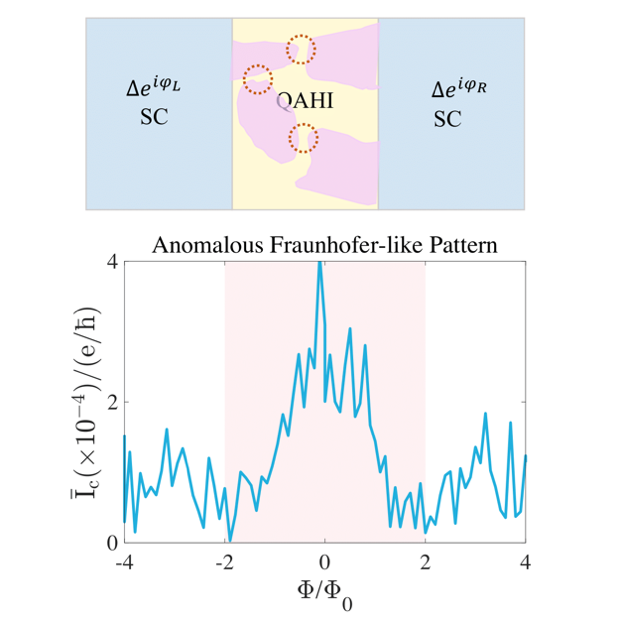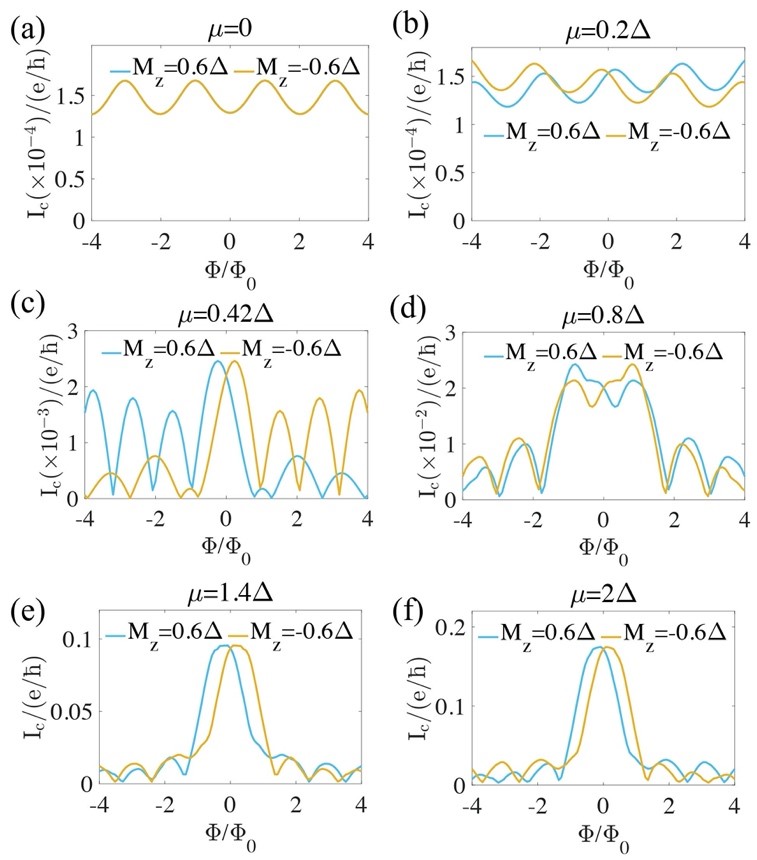Topological Quantum Computation Team of BAQIS has made new advancements in the study of Josephson junctions based on the quantum anomalous Hall effect
2024/06/20
Recently, the Topological Quantum Computation Team at the Beijing Academy of Quantum Information Sciences (BAQIS) and Prof. Chui-zhen Chen's group from Soochow University collaboratively discovered an anomalous Fraunhofer-like pattern in Josephson junctions based on the quantum anomalous Hall effect, induced by magnetic domains (see Fig. 1). Their research, titled "Anomalous Fraunhofer-like Patterns in Quantum Anomalous Hall Josephson Junctions," was published in Physics Review Research (Editors’ Suggestion) on June 18, 2024.
The quantum anomalous Hall effect (QAHE) features dissipationless chiral edge states, making QAHE/superconductor heterostructures promising platforms for realizing topological superconductors. The chiral Josephson junction formed by such heterostructures is fundamental for topological quantum computing and quantum information applications. Theoretical studies suggest that in ideal chiral Josephson junctions, edge supercurrents exhibit periodic oscillations with a period of h/e (where h is Planck's constant and e is the electron charge) in response to an external magnetic field. However, experimental observations in QAHE systems, composed of magnetically doped topological insulator thin films, indicate the inevitable presence of bulk carriers induced by magnetic domains. Thus, investigating the impact of bulk carriers on the interference patterns of Josephson junctions under external magnetic fields is crucial for guiding experimental measurements in real systems.

Fig.1 Schematic diagram of magnetic domains in chiral Josephson junctions and the anomalous Fraunhofer-like pattern
Researchers investigated the evolution of quantum interference patterns under an external magnetic field by tuning the system's Fermi level, transitioning from edge-dominated supercurrents to bulk-dominated supercurrents. When the Fermi level is within the bulk gap, only chiral edge states participate in transport, resulting in h/e periodic oscillations (Figs. 2(a) and 2(b)). As the Fermi level is tuned to the conduction band, both edge and bulk carriers contribute to transport, disrupting the h/e periodic oscillations (Figs. 2(c)-(e)). When the Fermi level is raised further, bulk carriers dominate the transport, and the quantum interference pattern exhibits a Fraunhofer pattern under the external magnetic field (Fig. 2(f)).

Fig. 2 Quantum interference patterns in different regimes under an external magnetic field. Evolution from edge-dominated supercurrents to bulk-dominated supercurrents.
On the other hand, bulk carriers induced by magnetic domains also inevitably contribute to transport, even when the Fermi level remains within the bulk gap. Researchers employed a percolation model to simulate magnetic domains and calculated their impact on quantum interference patterns, revealing an anomalous Fraunhofer-like pattern. This phenomenon is likely widespread in chiral Josephson junctions doped with magnetic impurities, offering significant insights for future experimental investigations.
The first author of this paper is Dr. Junjie Qi, an Assistant Researcher of BAQIS. The corresponding authors are Dr. Junjie Qi and Prof. Chui-zhen Chen from Soochow University. Key collaborators include Prof. X. C. Xie, an Academician of Chinese Academy of Sciences from Peking University and Fudan University, Prof. Ke He from Tsinghua University and BAQIS, Prof. Dong E. Liu from Tsinghua University and BAQIS, Prof. Hua Jiang from Fudan University, Prof. Haiwen Liu from Beijing Normal University, and Prof. Jie Liu from Xi'an Jiaotong University. This work is supported by the Innovation Program for Quantum Science and Technology, the National Key R&D Program of China, the National Natural Science Foundation of China, the Natural Science Foundation of Jiangsu Province, and the Priority Academic Program Development (PAPD) of Jiangsu Higher Education Institution.
Link to the paper:
https://journals.aps.org/prresearch/abstract/10.1103/PhysRevResearch.6.023293
 中文
中文 Email
Email QCloud
QCloud Log in
Log in
